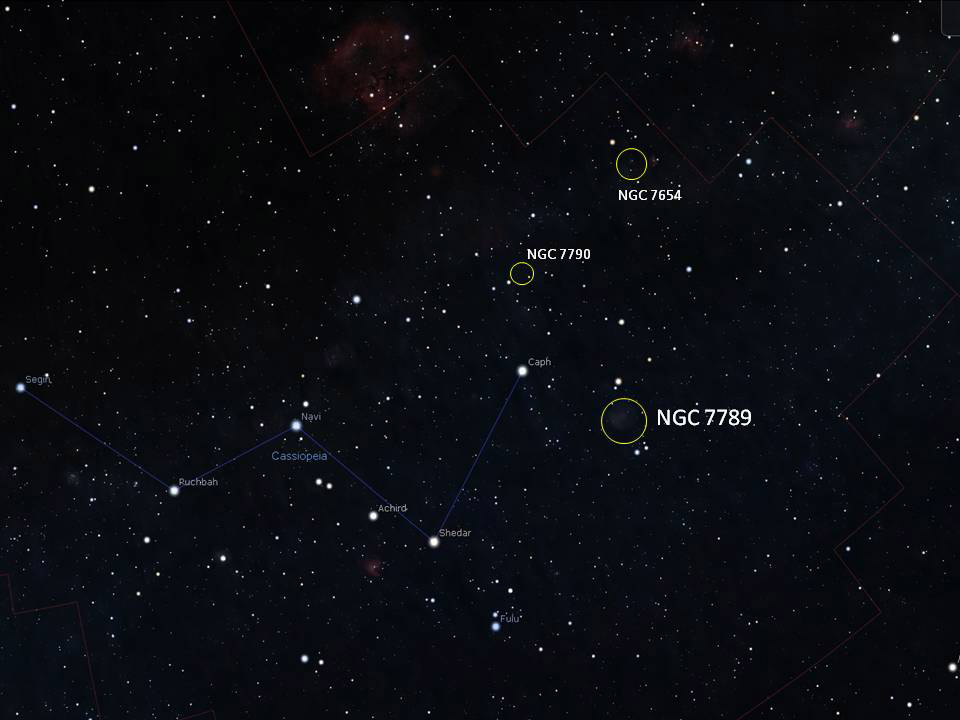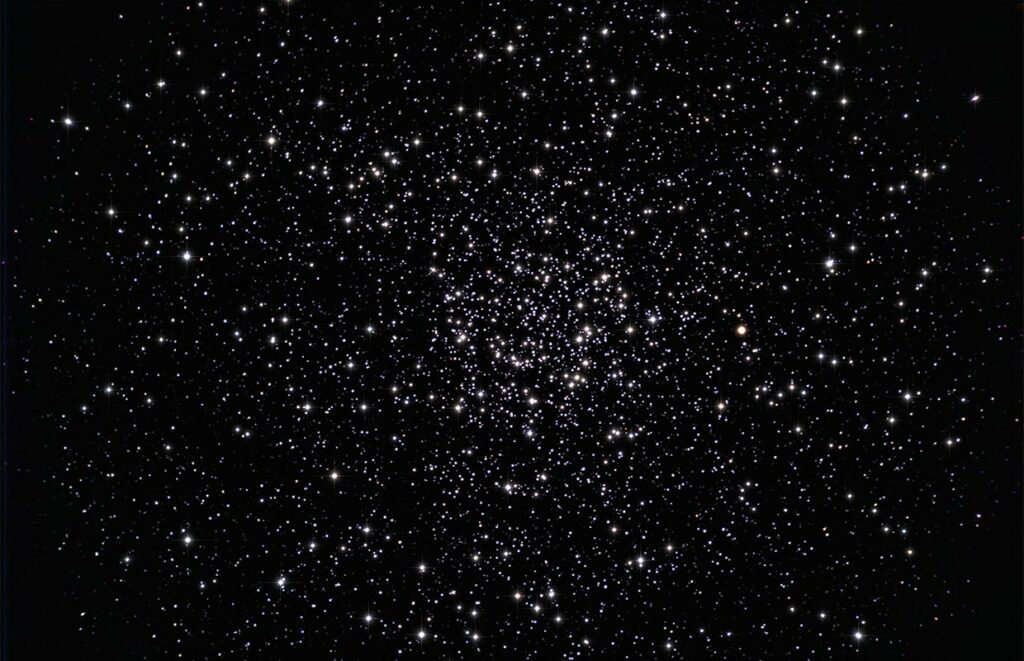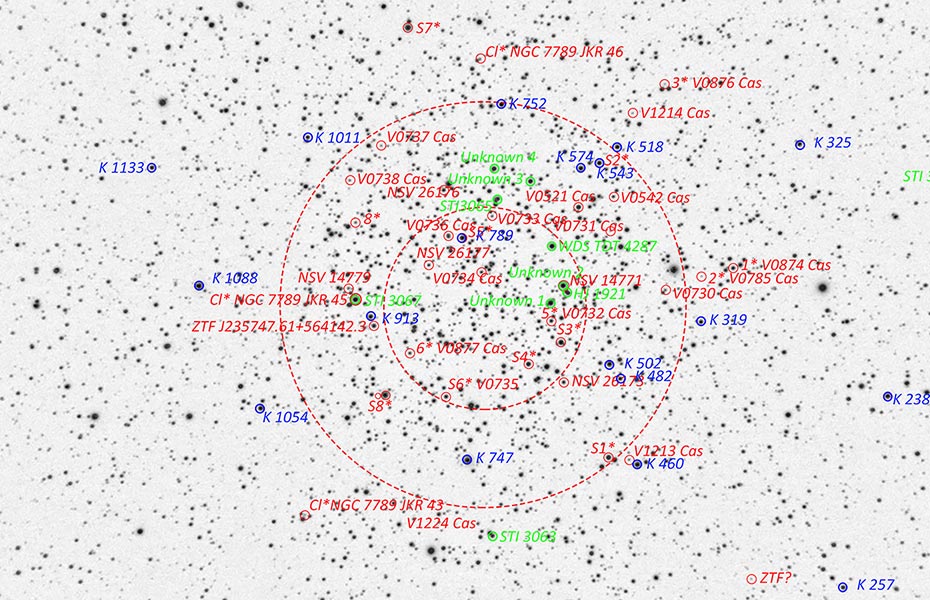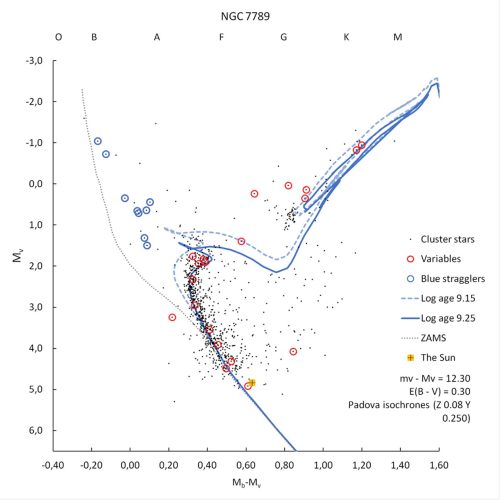NGC 7789 er lausþyrping í stjörnumerkinu Kassíópeiu (mynd 1). Hún situr í þunnkringlu Vetrarbrautarinnar sem er rík af stjörnum. Caroline L. Herschel (1750-1848), systir og samstarfsfélagi stjörnufræðingsins Friedrich W. Herschel (1738–1822), uppgötvaði hana árið 1783. Hún er því gjarnan kölluð þyrping Karólínu. Í Nýju himinþokuskránni, yfir >7840 djúpfyrirbæri, sem var fyrst útgefin seint á 19. öld. Þar er þyrpingunni lýst sem mjög víðri, þéttri og auðugri af stjörnum af birtustigi 11-18. Myndir staðfesta talsverðan fjölda daufra stjarna og bjarta rauðrisa en engar bláhvítar risastjörnur eru á meðal þeirra (mynd 2).
NGC 7789 is an open cluster in the constellation Cassiopeia (Fig. 1). The cluster resides in the thin galactic disk, a region in the Milky Way galaxy rich in stars and dust. Caroline L. Herschel (1750–1848), sister and colleague of the astronomer Friedrich W. Herschel (1738–1822), discovered it in 1783. It is therefore often called the Caroline cluster. In the New General Catalogue of >7840 deep objects, first published in the late 19th century, the cluster is described as very wide, dense, and rich in stars of magnitudes 11 to 18. Images confirm a considerable number of faint stars and bright red giants, but there are no blue-white giant stars among them (Fig. 2).

Mynd/fig. 1. Á kortinu (unnið í forritinu Stellarium) er NGC 7789 merkt, ásamt NGC 7790 og NGC 7654 (M 52). — On the map (prepared with Stellarium) the location of the cluster NGC 7654 is marked, along with NGC 7790 and NGC 7654 (M 52).
Þyrpingin er heppilega staðsett fyrir athuganir frá Íslandi því að hún fer nærri hvirfilpunkti. Þar má mynda í gegnum minnstan loftmassa og taka skarpar myndir. Þessi staðreynd var höfundi hvatning til að afla gagna sem nota mætti til að meta fjarlægð, roðnun og aldur þyrpingarinnar með meginraðarmátun. Þegar þyrpingin er mynduð við slík skilyrði með 40 cm sjónauka má nema fjölda stjarna vegna þess hve vel þær aðgreinast.
The cluster’s seasonal near-zenith transit, seen from Iceland in the winter, makes it a suitable target for studies. This fact encouraged the author to utilise good conditions for optical resolution and collect data with a 40-cm telescope with the intention of estimating its distance. Obviously, a much larger, high-resolution telescope is better for such tasks, but the goal was to test how far one can go using a small instrument.

Mynd/fig. 2. Þyrpingin NGC 7789 (Þyrping Karólínu) í Kassíópeiu. Myndin var tekin með 40 cm f/10 sjónauka búnum f/6,3 brennivíddarstytti og SBIG STL11kM myndflöguvél. — The open cluster NGC 7789 (Caroline’s cluster) in Cassiopeia. The image was captured with a 40 cm SCT f/10 ACF, f /7.5 focal reducer and SBIG STL 11kM camera.
Alls tókst að ljósmæla 953 stjörnur í þyrpingunni, á B, V og R litsviði, og voru niðurstöðurnar notaðar í þéttleikasnið, auk þess að bera þýðið við jafnaldurslínur á H-R línuriti. Tekið var tillit til þekktra breytistjarna og tvístirna í þyrpingunni til þess að fá glöggar niðurstöður á litvísi stjarna (mynd 3).
A total of 953 stars in the cluster were measured in the B, V, and R colour bands, and the resulting magnitude and index matched with a Padova isochrones on a Colour-Magnitude Diagram for main sequence fitting, to estimate the cluster distance, and reddening. Known variable stars and binaries in the cluster were taken into account in order to obtain clear results on the colour index of stars (Fig. 3).

Mynd/fig. 3. NGC 7789, ásamt þekktum breytistjörnum (rauðir hringir), tvístirnum (grænir hringir) og blávillingum (bláir hringir). — The field of the open cluster NGC 7789, with known variable stars (red circles), binary stars (green circles), and blue stragglers (blue rings).
Niðurstöður úr athugunum sem höfundur gerði árið 2020, staðsetja NGC 7789 í 6126 ljósára fjarlægð. Þær eru á pari við niðurstöður úr fyrri mælingum sem hafa verið gerðar af jörðu niðri en ber ekki saman við mælingar með Gaia gervitunglinu, sem ákvarða fjarlægð hennar 6763 ljósár. Þrátt fyrir þennan mismun gefa þær ásættanlega vísbendingu um hve fjarri hún er, að mati höfundar.
The results from the author’s observations in 2020 locate it at a distance of 6126 light-years.That estimation aligns well with results from several earth-bound studies. However, recent studies based on measurements with the Gaia satellite places the cluster at a distance of 6763 light-years. Despite the discrepancies, the author considers the results to be an acceptable indication of how distant it is.

Mynd/fig. 4. NGC 7789 mátuð á meginröð. Litvísir (B—V) er á þverás og reyndarbirtustig (Mv) á lóðás. – NGC 7789 fitted to the main sequence. Color index is on x-axis and absolute magnitude on y-axis.
Reyndarbirta bjartari stjarna á meginröð 1,4 til 3,8 af H-R línuritinu að dæma (mynd 4). Þessar stjörnur eru í litrófsflokkum A5 til F5, yfirborðshiti þeirra er 6900–7500 K, og og massinn 1,3–2,1 sólarmassar. Slíkar stjörnur þróast fyrr af meginröð en sólin mun gera (Walker 2017). Eftir alrófsleiðréttingu ákvarðast björtustu stjörnurnar á meginröðinni af bst. 1,0 til 3,4 (reyndarbst. sólar er 4,6) og þær eru ~3-10falt bjartari en sólin. Til viðmiðs er merktur gulur kassi neðarlega á mynd 4 sem miðast við reyndarbirtu sólar og litvísi.
The absolute magnitude of the brighter main sequence stars range between 1.4 and 3.8, according to the H-R diagram (Fig. 4). These stars belong to spectral classes A5 to F5, have a surface temperature of 6900-7500 K, and a mass of 1.3-2.1 solar masses. Such stars evolve faster from the main sequence than the sun will (Walker 2017). After bolometric correction, the brightest main sequence stars are of absolute magnitude 1.0 to 3.4 (the sun’s absolute magnitude is 4.6) and they are approximately 3–10 times brighter than the Sun. For reference, a yellow box is marked near the bottom of figure 4, showing the sun’s absolute magnitude and colour index.
Klasi þróaðra rauðrisastjarna situr við hlykk á RGB greininni. Jafnaldurslínurnar rekja þróunarferil þeirra, fyrst upp til hægri eftir RGB greininni en síðan að nokkru tilbaka þar sem að þær safnast í klasa. Vetnisforði í kjarna til orkuframleiðslu er gengin til þurrðar og þær nýta þess í stað helín. Við umskiptin dregst kjarninn saman, hitastig stjarnanna hækkar og ytri lög þenjast út og kólna. Litvísir klasans staðfestir rauðari stjörnur og samtímis bjartari en þær sem dvelja á meginröðinni. Hópurinn bendir eindregið til þess að þyrpingin sé gömul.
The RGB branch forms a loop where a group of evolved red giant stars is located. The isochrones trace their development off the main sequence, diagonally up to the right along the RGB branch and then shift back a little, where they gather in the group. Due to the depletion of hydrogen supplies in the core, helium is now used in its place for energy production. The process leads to the star’s core compressing, its temperature rising, and its outer layers expanding and cooling. The colour index confirms redder stars and is simultaneously brighter than those residing in the main sequence. The group strongly suggests that the cluster is old.
Að síðustu má nefna blávillinga sem voru innan marka þyrpingarinnar. Þeir eru bjartari og blárri (heitari) en stjörnur við fráhvarfspunkt, sem ættu að teljast björtustu stjörnur þyrpingarinnar.
Finally, a number of stars residing within the boundaries of the cluster are the blue stragglers, which are hotter and bluer than the brightest main sequence members.
Ýtarlegri greinargerð um mælingarnar er í samantekt yfir athuganir frá stjörnustöðinni í Nesjum 2022 (8 Mb).
A more comprehensive version of the measurements is written in the 2022 Nes Observatory report (mostly in Icelandic, summary in English, 8 Mb).
Höfundur vill árétta að þó að ljósmælingar á þessari þyrpingu hafi verið gerðar með tiltölulega litlum sjónauka var WEBDA gagnagrunnurinn nýttur við rannsóknina, en hann er starfræktur við kennilega eðlisfræði- og stjarneðlisfræðideild Masaryk háskólans í Tékklandi. Vefsíða WEBDA um NGC 7789 má finna hér. Stjörnufræðigagnamiðstöð Strasbourg (SImbad) varðveitir stórt safn upplýsinga á meira en 17,7 milljón stjarnfyrirbærum. Hér er vefsíða þyrpingarinnar NGC 7789.
The author emphasizes that although the photometry of this cluster was made with a relatively small telescope, this research made use of the WEBDA database, operated at the Department of Theoretical Physics and Astrophysics of Masaryk University. The WEBDA NGC 7789 page is located here. The Strasbourg astronomical Data Center preserves a large collection of information on more than 17.7 million astronomical objects. Here is the access to the website for NGC 7789.